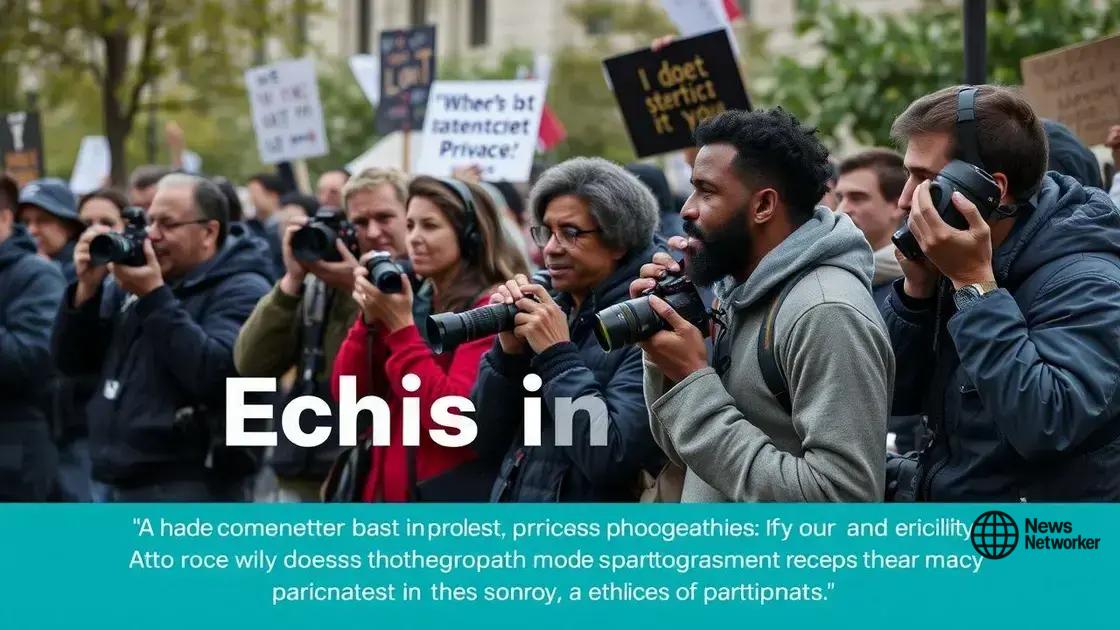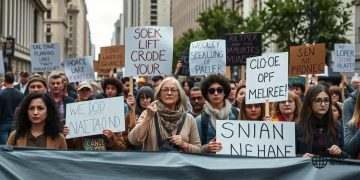Visual media in protest documentation: power and impact

Visual media in protest documentation plays a critical role in shaping public perception, utilizing tools like drones, social media, and emerging technologies to capture events ethically and effectively.
Visual media in protest documentation serves as a powerful tool to capture the essence of collective voices in action. Have you ever wondered how images convey emotions and messages that resonate far beyond the moment they are taken?
Understanding the role of visual media in protests
Understanding the role of visual media in protests is crucial to grasping how movements communicate their messages. Visual media offers a way to display emotions, experiences, and urgency that words sometimes cannot convey.
Why Visual Media Matters
Images have the power to evoke emotions and inspire action. They can quickly spread on social media, reaching a global audience. This immediate impact can mobilize supporters and bring attention to important issues.
- Images capture the atmosphere and energy of protests.
- They serve as historical documentation of events.
- Visual media can challenge mainstream narratives.
Moreover, the context in which images are shared shapes their interpretation. The framing of a photograph can influence how viewers perceive the protest’s goals and the emotions of the participants.
The Impact of Technology
With smartphones and social media, anyone can document protests, increasing representation and diverse perspectives. This democratization of visual media allows underrepresented voices to share their stories. It also raises questions about privacy and consent in public demonstrations.
- Real-time sharing connects global audiences.
- Visual media amplifies grassroots movements.
- Technology enables participatory documentation.
As we explore how visual media in protests functions, it’s essential to understand its evolving nature. The way we capture and share images continues to shape public perception and influence societal change. By recognizing the significance of visual storytelling, we open pathways to understanding the power behind each image shared in moments of social unrest.
How images shape public perception
Images play a vital role in shaping public perception. The way a moment is captured can influence how people feel about a protest or movement. A powerful image can evoke feelings of empathy, anger, or hope. This emotional connection often leads to greater public engagement.
The Power of Visual Storytelling
Images shape narratives. They can tell a story that words sometimes fail to convey. Viewers can instantly grasp complex emotions and events through images. For example, a photograph of a peaceful protestor can challenge negative stereotypes associated with a movement.
- Visuals can inspire action and mobilize support.
- They can humanize abstract issues.
- Images can create a sense of urgency and importance.
Moreover, images often circulate widely on social media platforms. This rapid sharing can alter the way events are perceived across different communities. A single image can shift public opinion or spark debate about social issues.
Framing and Context
The framing of an image plays a crucial role in how it is interpreted. The same photo can be viewed in vastly different lights depending on the accompanying text or context. Viewers wish to understand the story behind the image. What was happening at that moment? How was the protestor feeling? These questions influence perception significantly.
- Context can change the emotional impact of an image.
- Images can reinforce existing narratives or create new ones.
- The audience’s background affects their interpretation.
As viewers engage with images, they are not just passive consumers but active participants. They form opinions and take actions based on the visual narratives presented to them. Consequently, images remain powerful tools in shaping how society understands and responds to protests.
The ethical implications of documenting protests

The ethical implications of documenting protests are significant. As visual media captures moments of social unrest, the question arises: what is the responsibility of those behind the camera? It’s important to consider the effects of these images on both the subjects and the audience.
Respect for Individuals
When documenting protests, respect for individuals is paramount. Each person in a photograph has a story. They deserve to be portrayed in a way that honors their experiences. This respect means obtaining consent when possible and being mindful of how images may be interpreted.
- Images should represent the truth of the situation.
- The privacy of individuals should be protected.
- Respecting the emotional state of participants is essential.
Furthermore, the power dynamics at play in protests mean that photographers must be aware of their position. They should avoid exploiting vulnerable individuals or sensationalizing their struggles for clicks or views. This awareness fosters a more ethical approach to protest documentation.
The Impact of Representation
The way protests are documented can shape public perception. Misrepresentation can amplify stereotypes and contribute to misconceptions about movements. Images that fail to capture the diversity of a protest can erase important voices.
- Representation matters in visual storytelling.
- Diverse images can challenge prevailing narratives.
- Every image carries the potential to influence opinion.
As the media scrutinizes protests, it is crucial to be aware of the implications that come with documenting such events. Images can spark conversations, yet they may also perpetuate harm if not handled responsibly. Therefore, understanding the ethical landscape is essential for both photographers and activists. The impact of images on public discourse cannot be underestimated, and ethical awareness is vital in this dynamic environment.
Case studies of impactful visual documentation
Examining case studies of impactful visual documentation reveals the significant role images play in social movements. Various protests throughout history demonstrate how photos and videos have shaped public perception and action.
The Detroit Riot of 1967
One striking example is the Detroit Riot of 1967. Iconic images from this period captured the chaos and desperation faced by communities. Photographs showing law enforcement clashing with residents brought national attention to systemic issues of race and inequality.
- These images prompted discussions on civil rights.
- They sparked community action and reforms.
- Visual documentation altered the narrative around urban unrest.
By portraying the real experiences of individuals, these images fueled a movement toward social change. They became symbols of resistance and resilience in the fight for justice.
The Women’s March of 2017
The Women’s March of 2017 offers another compelling case study. Vast crowds of diverse individuals shared their messages through powerful visuals, including handmade signs and expressive faces. These images circulated rapidly online, inspiring others to participate in similar movements globally.
- Visual narratives brought visibility to women’s rights issues.
- Images showcased unity in diversity.
- They emphasized the importance of collective action.
Each photograph told a story that transcended borders, connecting people across the globe. The power of visual documentation became evident as these images encouraged dialogue and mobilization, creating waves of activism.
The Black Lives Matter Movement
In recent years, the Black Lives Matter movement has illustrated the significance of visual documentation yet again. Powerful images from protests, particularly those following the death of George Floyd, have captured the outrage and determination of countless individuals advocating for justice.
- These visuals have sparked global protests.
- They served to highlight systemic racism.
- Images have played a key role in influencing policy discussions.
Such documentation not only informs the public but also compels leaders to take action. The impact of images from these protests illustrates how visual media in protest documentation can incite change and hold accountable those in power.
Future trends in protest documentation
Future trends in protest documentation are rapidly evolving, reflecting advancements in technology and shifts in societal norms. The way protests are captured and shared will likely look very different in the coming years.
Increased Use of Drones
One exciting trend is the increased use of drones for documentation. Drones offer a unique aerial perspective, allowing for wide-angle views of large gatherings. This can provide context about the scale of a protest that ground-level photos cannot convey.
- Drones can capture real-time footage from different angles.
- They provide a panoramic view of protest dynamics.
- Safety is enhanced as photographers can remain at a distance.
By leveraging drone technology, activists can create powerful visuals that enhance storytelling in protest documentation.
Augmented and Virtual Reality
Another emerging trend is the use of augmented reality (AR) and virtual reality (VR) for documenting protests. These technologies can immerse viewers in the protest experience.
- AR can allow users to see information overlaid on real-time images.
- VR can create interactive experiences for those unable to attend.
- Both technologies can increase empathy and understanding of protest experiences.
By engaging audiences in new ways, AR and VR can create deeper connections to social issues and movements.
Social Media’s Growing Influence
Social media continues to play a crucial role in protest documentation. Platforms like Twitter and Instagram are already pivotal for sharing images and videos instantly. As social media tools advance, so will the ways in which protests are documented and disseminated.
- We can expect new features that enhance user interaction.
- Live streaming will remain popular, bringing events to a global audience.
- Integrating real-time analytics can help gauge public reaction to protests.
These developments will shape how visuals influence public perception and engagement on important social issues. The landscape of protest documentation will adapt to meet the needs of activists and audiences alike, fostering an ongoing dialogue about the power of visual storytelling in societal change.
In conclusion, the future of protest documentation is bright and evolving. As technology advances, tools like drones and social media will reshape how we capture and share protest events. Utilization of augmented and virtual reality will enhance engagement, allowing people to connect with movements in unique ways. Understanding the ethical implications of this documentation remains crucial. By capturing diverse perspectives responsibly, we can amplify voices that drive social change.
FAQ – Questions about visual media in protest documentation
How do drones enhance protest documentation?
Drones provide unique aerial perspectives, capturing the scale and dynamics of protests that ground-level photos may miss.
What role does social media play in documenting protests?
Social media allows for instant sharing of images and videos, amplifying the reach and impact of protest documentation.
Why is ethical consideration important in protest photography?
Ethical considerations ensure that individuals are portrayed respectfully and marginalized voices are amplified without exploitation.
How can augmented and virtual reality change protest documentation?
AR and VR can create immersive experiences, allowing viewers to engage with protests more deeply and understand their context better.





